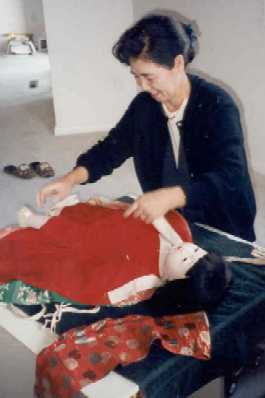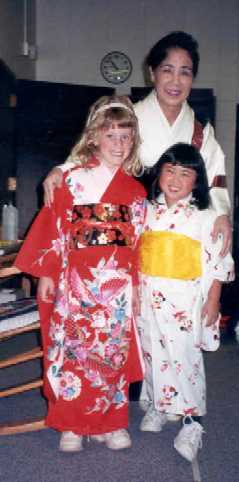|
|
|

|

|
Carefully redressing
Miss Yokohama
|
|
|
I first saw Kazuko Tamaoki when she visited the Japanese American National
Museum in Los Angeles on August 10 to attend a panel
discussion about the Friendship Dolls exchanged between Japan and America. Mrs. Tamaoki
presented new Japanese dolls to both Sidney Gulick,
3d, and Noriko Kohno to
express her gratitude for their involvement in Friendship Doll activities.
Since there were many people at the meeting, I did not have a chance at that
time to meet Mrs. Tamaoki. I was interested in talking with her since I had
heard she had restored the kimono for Miss
Okayama, one of the 58 Japanese Ambassador Dolls given to America in
1927, and had been involved in other activities related to Friendship
Dolls exchanged between the U.S. and Japan. Mrs. Tamaoki's daughter Yoko, who
lives in the Los Angeles area, relayed a message to her mother in Nagoya,
Japan, that I was
interested in finding out more about her Friendship Doll activities. I
arranged to meet Mrs. Tamaoki at her doll shop in Nagoya on a Sunday
afternoon.
This was my first visit to a doll shop in Japan (or anywhere in the
world), so I was not quite sure
what to expect. Mrs. Tamaoki, dressed in a kimono, came to the subway station
when I arrived, and we walked back together for a couple of blocks in the
rain to her two-story doll shop. The shop was filled with several types of
doll, but many were Suiho-style dolls personally designed and created by Mrs.
Tamaoki. Before my arrival at the doll shop, Mrs. Tamaoki had brought out many
photos and articles about the Friendship Dolls and the exhibition of her
dolls in several places around the world. We spent an enjoyable afternoon
looking at the photos and talking about her many activities to share Japanese
dolls and culture with others.
|
|
|

|
|
|
Kazuko Tamaoki (center) giving two of her dolls
to Sidney Gulick, 3d, and Noriko Kohno at the Japanese American National
Museum
|

|
|
|
During my afternoon chat, Mrs. Tamaoki described her many Friendship Doll
activities. I was amazed when she said that she personally donates about 40
dolls each year to the program sponsored by the Japanese Cultural Center of
the Mukogawa Fort Wright
Institute, which distributes the dolls to elementary schools throughout
the U.S. She also has made visits to five American schools to show the
children her dolls and talk about the culture of Japan. She expressed her
strong desire to continue to give dolls to schools and children in America to
foster international friendship and understanding. Mrs. Tamaoki has also provided much valuable assistance to the
preservation of the Japanese Ambassador Dolls sent from Japan to America in
1927. "I do not do it for money," says Mrs. Tamaoki. "I do it
because I like to make them look as beautiful as they were created to
be." She expertly redressed Miss
Yokohama in a 1995 visit to Colorado, and she purchased a display case so
the doll could be on permanent display. She also repaired the kimono for
Miss Okayama, which included supplying missing silk fabric for the lining of
the sleeves. Mrs. Tamaoki has also supplied and made accessories for
about five of the Japanese Ambassador Dolls. For example, she made an obijime
(fastener to hold the sash for the kimono) for Miss Kantoshu. Many of these
accessories have been provided after Mrs. Tamaoki found out about missing or
damaged accessories from Michiko
Takaoka, who has visited each of the 44 Japanese Ambassador Dolls that
have been found throughout the U.S.
|
|
|
|
|

|

|
Mrs. Tamaoki at Her Doll Shop in
Nagoya
|
|
|
After a long talk in Mrs. Tamaoki's doll shop, we walked a couple of
blocks to her doll factory. The small two-story factory now employs six women and one man,
but in the past as many as 30 people worked there. The workers sit on the
floor on tatami mats as they make dolls on low tables in a small second-floor
area crowded with various doll-making materials, such as numerous
brightly-colored rolls of silk for making the kimonos. Her company produces
each day about 20 handmade dolls, which are sold in department stores
throughout Japan. Mrs. Tamaoki personally makes about one doll a day, and this
includes dressing the doll in a kimono with obi (belt for kimono) and other
accessories. She creates the first mold of her dolls and designs the costumes
before allowing her staff to reproduce them.Mrs. Tamaoki received her Red
Master's seal in 1955 from the Ozawa Doll Institute. In 1961, she started her
doll making company, Dolls of Tamaoki, and established a doll school in
Nagoya. Mrs. Tamaoki gives many lectures on Japanese dolls and culture, and
she participates in numerous doll exhibitions. Through these lectures and
exhibitions, she shares her artistic and technical talents by creating her
exquisite dolls before her audiences. For example, for the last several years
she has visited Los Angeles in early August to exhibit her dolls at the Nisei
Week Japanese Festival. She seeks to introduce Japanese traditional arts to
people outside of Japan in order to create international goodwill. Her dolls
are owned and displayed throughout the world. On the walls of her shop are
displayed several of the many awards she has received for her doll making
skills.
|
|
|

|
|
Mrs. Tamaoki with
Two American Children
|

|
|
|
Both times I have seen Mrs. Tamaoki, once in LA and once in Nagoya,
smartly dressed in a kimono. Since most Japanese women nowadays do not wear
kimonos very often, I was very surprised when I found out she owns about 150
kimonos and wears one every day to work. Although Mrs. Tamaoki has reached
the age of 68, when many people have already retired, she still works
seven days a week at the occupation she loves so much. She also goes to
the U.S. about four times a year for three or four weeks each visit in
order to see her daughter's family in LA. However, even in the U.S. she
busies herself with the restoration of old dolls and making new dolls.Many
of Mrs. Tamaoki's dolls are designed in sets to represent some aspect of
Japanese culture. For example, one of her sets includes a grandmother
carrying her granddaughter to the temple for a dedication ceremony with
mother and brother walking along. Another set has a mother teaching her
daughter how to weave with an elaborate loom with miniature spools of
thread. Another shows two children in the snow, with the boy holding a
snow bunny he has made. The use of various accessories gives each set a
unique story to tell.
Mrs. Tamaoki has generously shared her talents to support many Friendship
Doll activities, and she expressed to me her strong desire to continue to
send Japanese dolls to American children so they may better understand
Japanese culture. If anyone is interested in obtaining a doll for children in
a school class, please send a note to the following e-mail address:
Suiho@earthlink.net.
|
|
|



